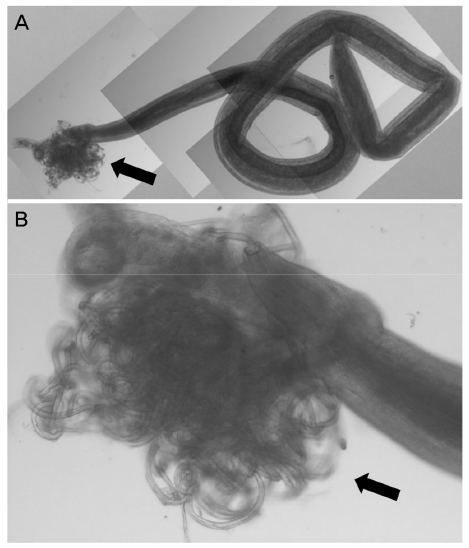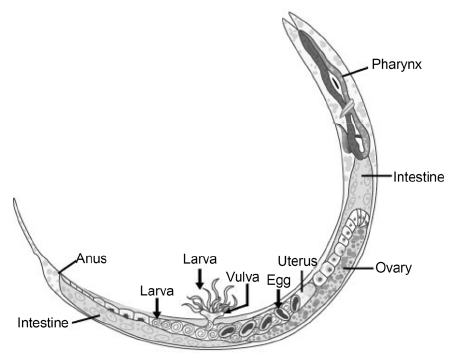J Korean Ophthalmol Soc.
2018 Feb;59(2):181-184. 10.3341/jkos.2018.59.2.181.
A Case of Thelazia callipaeda Infestation with Preseptal Cellulitis
- Affiliations
-
- 1Department of Ophthalmology, Pusan National University Yangsan Hospital, Pusan National University School of Medicine, Yangsan, Korea. Jiel75@hanmail.net
- 2Department of Parasitology, Pusan National University School of Medicine, Yangsan, Korea.
- 3Research Institute for Convergence of Biomedical Science and Technology, Pusan National University Yangsan Hospital, Pusan National University School of Medicine, Yangsan, Korea.
- KMID: 2403813
- DOI: http://doi.org/10.3341/jkos.2018.59.2.181
Abstract
- PURPOSE
To report a case of Thelazia callipaeda infection with preseptal cellulitis.
CASE SUMMARY
A 24-year-old female presented with symptoms of conjunctival injection and ocular pain in her left eye and a parasite was found in her conjunctival sac. Using light microscopy, we identified Thelazia callipaeda and many larvae were observed in the vulva of an adult female worm. Three days later, erythematous swelling occurred in the left upper eyelid and four adult worms were found and removed with forceps. Third-generation cephalosporin and nonsteroidal anti-inflammatory drugs were administered orally; the eyelid swelling improved but the conjunctival injection remained. Later five and seven adult worms were removed every 4 weeks and the conjunctival injection improved with no parasites detected after the final extraction.
CONCLUSIONS
In the case of Thelazia callipaeda infection, it is necessary to identify eggs and larvae and to observe the patient for more than 1 month because of postextraction growth of the larvae. In addition, the possibility of preseptal cellulitis by Thelazia callipaeda should be considered.
MeSH Terms
Figure
Cited by 1 articles
-
A Case of
Thelazia Callipaeda Ocular Infection Identified in Patients with Subarachnoid Haemorrhage
Shin Hee Hong, Tae Hun Kim, Hye Jin Shi, Joong Sik Eom, Yoonseon Park
Korean J Healthc Assoc Infect Control Prev. 2022;27(1):77-79. doi: 10.14192/kjicp.2022.27.1.77.
Reference
-
1. Oh CK, Youn WS, Cho SY, Seou BS. A case report of human thelaziasis. J Korean Ophthalmol Soc. 1975; 16:431–434.2. Kofoid CA, Williams OL. The nematode thelazia californiensis as a parasite of the eye of man in California. Arch Ophthalmol. 1935; 13:176–180.
Article3. Otranto D, Lia RP, Buono V, et al. Biology of Thelazia callipaeda (Spirurida, Thelaziidae) eyeworms in naturally infected definitive hosts. Parasitology. 2004; 129(Pt 5):627–633.
Article4. Nakata R. Study on Thelazia callipaeda. Jpn J Parasitol. 1964; 13:600–609.5. Otranto D, Traversa D. Thelazia eyeworm: an original endo- and ecto-parasitic nematode. Trends Parasitol. 2005; 21:1–4.6. Choi YJ, Shin GR, Kim YD. A case of subconjunctival Thelasia callipaeda infestation. J Korean Ophthalmol Soc. 2016; 57:1476–1479.
Article7. Jeong JW, Park JW, Kong HH, et al. A Case of Intraocular Thelasia Callipaeda Infestation. J Korean Ophthalmol Soc. 2006; 47:1517–1522.8. Lee SM, Shin KM, Kim DH, Kang BN. A case of Thelazia callipaeda recurred at a one-month interval. J Korean Ophthalmol Soc. 2010; 51:895–898.
Article9. Yang YK, Cho YK, Ahn YK, et al. Micrograph morphology of Thelazia callipaeda Railliet et Henry, 1910 Infection in Conjunctiva. Korean J Biomed Lab Sci. 1997; 3:43–47.10. Kim YK, Song BR, Yoo JH, Yong TS. Two cases of human thelaziasis. J Korean Ophthalmol Soc. 1994; 35:223–228.11. Lee SW, Kang SW, Lee JO, Eom KS. Two cases of thelazia callipaeda infestation. J Korean Ophthalmol Soc. 1994; 35:1132–1136.12. Lee KW, Han KS. A case of orbital cellulites complicated subdural abscess. J Korean Ophthalmol Soc. 1981; 22:475–478.13. Gilhooly MG, Falconer DT, Wood GA. Orbital subperiosteal abscess and blindness complicating a minimally displaced zygomatic complex fracture. Br J Oral Maxillofac Surg. 1995; 33:185–188.
Article14. Choudhury AR. Thelaziasis. Am J Ophthalmol. 1969; 67:773–774.
Article15. Zakir R, Zhong-Xia Z, Chiodini P, Canning CR. Intraocular infestation with the worm, Thelazia callipaeda. Br J Ophthalmol. 1999; 83:1194–1195.
Article




